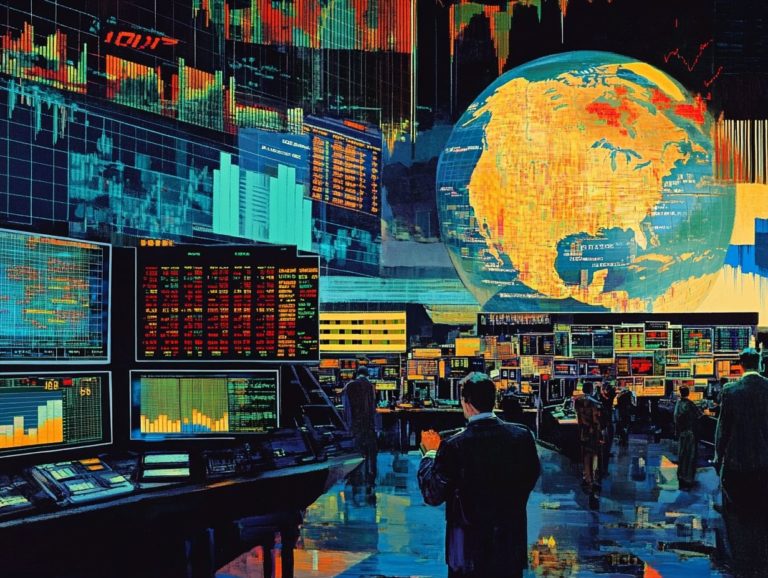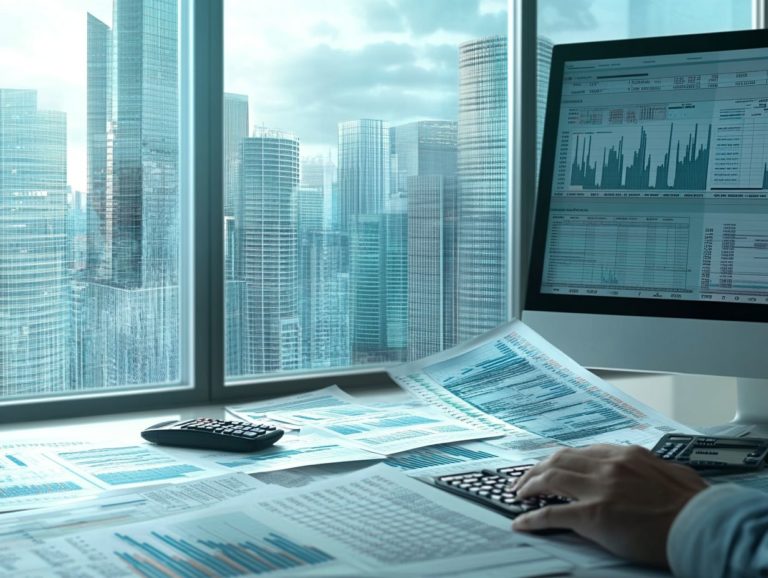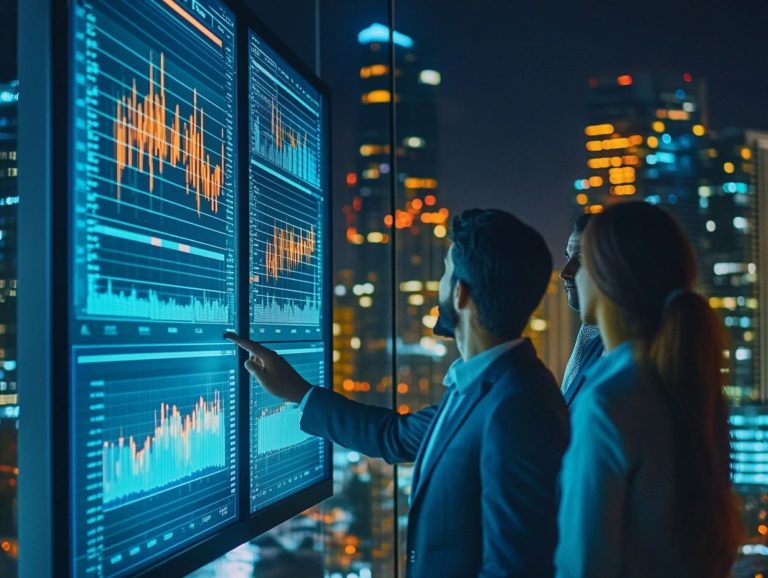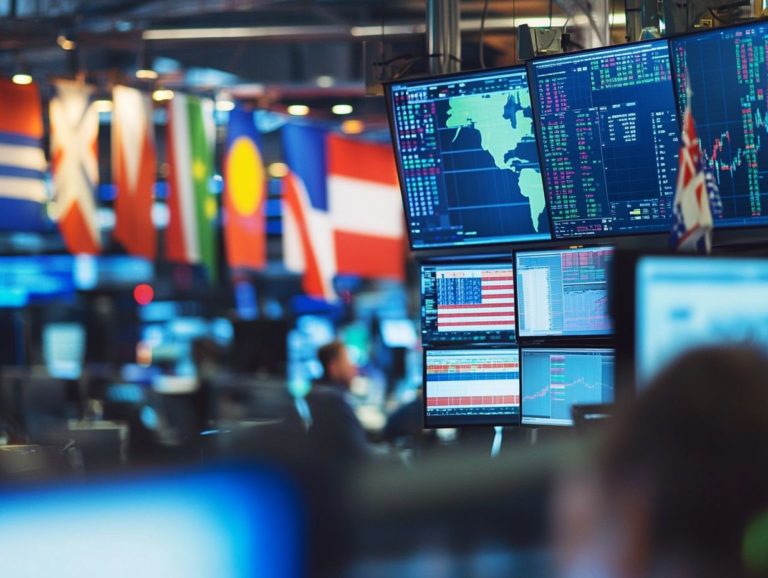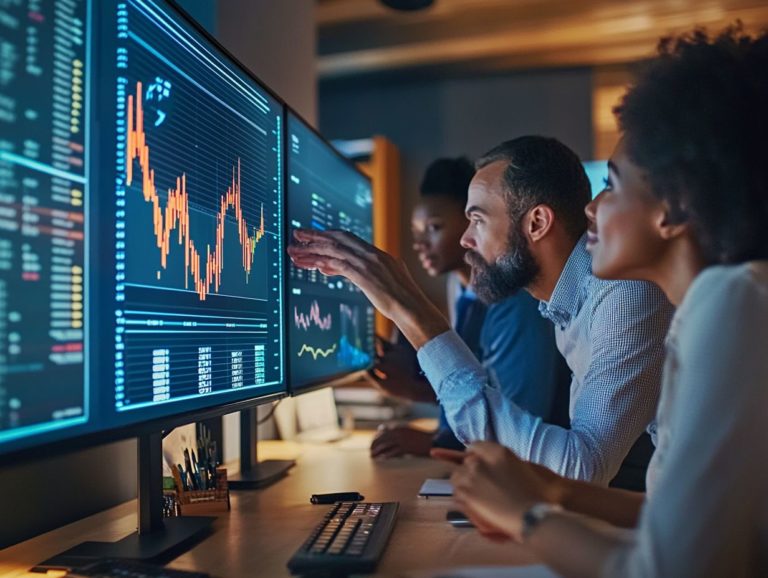Latest Trends Affecting Global Economic Conditions
In today’s rapidly changing landscape, grasping the current trends that influence the global economy is crucial for both businesses and individuals.
This article delves into the key economic conditions shaped by technological advancements, shifting demographics, and political dynamics. It explores how these factors present themselves differently across various regions and industries, uncovering the unique challenges and opportunities that arise.
You ll also find expert predictions looking ahead, along with strategies to effectively navigate these changes. Discover how to thrive amid uncertainty and turn challenges into opportunities.
Contents
- Key Takeaways:
- Current Trends in the Global Economy
- Effects on Different Regions and Industries
- Future Predictions and Projections
- Strategies for Navigating Changing Economic Conditions
- Frequently Asked Questions
- What are some of the latest trends affecting global economic conditions?
- How are changing consumer behavior and trends impacting the global economy?
- What role do technological advancements play in shaping the global economy?
- How is climate change affecting the global economy?
- What geopolitical shifts are currently influencing global economic conditions?
- What are some potential consequences of the latest trends on the global economy?
Key Takeaways:

- The global economy is constantly evolving due to technological advancements, changing demographics, and political and social factors.
- Regional variations and industry-specific trends have a significant impact on economic conditions around the world.
- Businesses must be prepared to adapt to shifting trends and mitigate risks in order to succeed in a constantly changing economic landscape.
Current Trends in the Global Economy
The current trends in the global economy reveal a complex interplay of factors that you can t afford to overlook. The lingering fiscal challenges, worsened by the COVID-19 pandemic, have prompted countries to rethink their economic strategies.
While inflation is on the decline and job growth is making a comeback, consumer confidence seems to be stabilizing. However, the labor market still has its fragilities, urging policymakers to implement smart spending strategies that cater to the needs of smaller states and the broader economic landscape.
Interest rates, swayed by decisions from influential entities like the Federal Reserve and the International Monetary Fund, are pivotal in shaping these trends.
Defining Economic Conditions
Defining Economic Conditions requires you to grasp how various factors like fiscal challenges, job openings, and labor market dynamics interact to paint a comprehensive picture of economic health.
As inflation begins to decline, the spotlight shifts toward sustainable economic growth and employment levels, impacting both consumers and businesses.
Take the Midwest as an example: a resurgence in manufacturing jobs signals a recovering economy. However, metropolitan areas may grapple with persistent unemployment, even with a wealth of job openings in tech industries.
In some markets, high inflation rates can erode consumer purchasing power, creating a stark contrast in economic well-being across different states.
In the retail sector, businesses find themselves navigating the tricky waters of adjusting prices in response to fluctuating costs. This, in turn, influences consumer behavior and spending patterns.
These indicators not only reflect current economic conditions but also serve as harbingers of future trends that could reshape various industries.
Impact of Technological Advancements
The impact of technological advancements on the economy can be profound, especially in cultivating a vibrant creator economy that spurs job growth and reshapes the labor market.
As new innovations emerge, they not only influence economic growth but also compel policymakers to adapt global strategies to effectively harness these advancements.
You can see this shift in the rise of platforms like YouTube and Etsy, where individuals monetize their creativity and transform hobbies into viable careers. These platforms have democratized content creation and invigorated local economies by giving power to micro-entrepreneurs.
Advancements in artificial intelligence and automation are redefining job roles. They create a demand for new skills and prompt educational institutions to revise their curricula.
In response, countries are rolling out initiatives like universal basic income and retraining programs, aiming to mitigate displacement while capitalizing on the economic potential of a digitally skilled workforce.
Don’t miss out on these strategies that could change your future!
We invite you to share your thoughts or subscribe for updates to stay informed about the latest trends and strategies in the global economy.
Changing Demographics
Changing demographics play a pivotal role in shaping economic landscapes. They directly influence job openings and the dynamics of the labor market in various regions, especially in smaller states.
As demographics shift, pressing issues such as keeping finances healthy and the impacts of climate change arise. These changes call for strategic economic planning.
An aging population threatens to create a serious shortage of skilled workers, urging industries to act fast by investing in automation or rethinking their workforce strategies. Conversely, an influx of younger populations can breathe new life into local economies. However, it also places considerable pressure on infrastructure and public services.
These demographic shifts challenge traditional economic models and demand a reassessment of government financial plans to ensure resources are allocated efficiently. Vulnerable regions, particularly those at risk from climate change, face additional obstacles as they navigate these changes while striving for sustainable growth.
Thus, adapting to these evolving conditions is essential for maintaining long-term economic viability. How will changing demographics impact your local job market? Stay informed!
Political and Social Factors

Political and social factors significantly influence fiscal challenges and economic growth. The relationship between governance and societal expectations shapes the labor market landscape.
In an era marked by declining inflation, understanding these factors is essential for crafting effective global policies that tackle economic disparities. For example, consider the labor market dynamics in countries like Germany and Brazil.
In Germany, a strong social safety net supports a well-trained workforce capable of adapting to industry changes. In contrast, Brazil’s political instability has eroded investor confidence, contributing to persistently high unemployment rates.
Fiscal policies influenced by societal demands often steer public investment in education and technology. This further impacts economic resilience. By exploring such case studies, it becomes clear that the alignment of political authority with social needs can either enhance or undermine economic prospects across various contexts.
Effects on Different Regions and Industries
The effects on different regions and industries are profoundly far-reaching. Challenges to fiscal sustainability take on various forms, including financial troubles due to high debt levels, natural disasters, and the impacts of climate change.
Each of these factors directly influences local housing markets. Grasping these regional variations is crucial for developing effective economic policies and strategies that cater to the unique needs of each area.
Regional Variations in Economic Conditions
Regional variations in economic conditions reveal the distinct challenges small states encounter. This is particularly true when addressing fiscal sustainability and debt distress issues that can stifle overall economic growth.
Acknowledging these disparities is essential for crafting tailored solutions that meet the unique needs of each region. Take the Caribbean, for example.
Here, small island economies often contend with public debt levels averaging around 80% of GDP, a stark difference from larger nations. This heavy debt load, coupled with vulnerability to natural disasters, places an immense strain on fiscal capacities.
As a result, it can limit critical investments in infrastructure and healthcare. On the other hand, Pacific island states face their own set of challenges, such as their remoteness and heavy reliance on tourism an industry vulnerable to global economic shifts.
These instances highlight the urgent need for specific, nuanced policies that foster sustainable development across diverse regional contexts. How can these regional variances inform better economic strategies? Stay engaged!
Industry-Specific Trends
Stay ahead of the curve! Industry-specific trends provide valuable insights into how various sectors, including the housing and labor markets, are shaped by current economic conditions and changes in government spending and tax policies. Understanding these trends gives you the power as a business leader or policymaker to make informed decisions that can drive job openings and bolster overall economic resilience.
For example, recent data reveals that the housing market is facing a slowdown. This is primarily due to rising interest rates that have increased mortgage costs by approximately 30% over the past year. This shift dampens consumer confidence and has a ripple effect on construction jobs, leading to an estimated 10% decline in housing starts in early 2023.
In contrast, the labor market shows significant demand in the tech and healthcare sectors, spurred by fiscal reforms focused on job creation. Experts emphasize that adapting to these evolving dynamics is essential for both sectors to flourish in an ever-changing economy.
Future Predictions and Projections
Future predictions and projections suggest that you must maintain fiscal sustainability to grow, particularly amidst ongoing labor shortages and the potential decline in inflation.
As various industries navigate these challenges, your understanding of the trajectory of job growth will be essential for effective planning. It s crucial to act now to prepare for upcoming shifts!
Expert Insights and Forecasts

Expert insights and forecasts are essential for shaping your understanding of future economic conditions, especially regarding global policies and fiscal reforms that influence job growth and overall economic prosperity. Engaging with these insights allows you to navigate the uncertainties of the economic landscape with more confidence.
By analyzing predictions from economists and industry experts, you can clarify how global trends such as trade agreements, technological advancements, and regulatory changes will impact the job market in the years ahead. The variety of viewpoints on the effectiveness of different fiscal policies illustrates the complexity of this topic. While some experts advocate for increased government spending to drive growth, others warn of potential deficits that could burden future generations.
These evolving narratives surrounding job creation and economic stability emphasize the necessity of staying informed and adaptable in an ever-shifting environment.
Navigating changing economic conditions requires you to employ effective strategies. Businesses and governments grapple with the dual challenges of ensuring fiscal sustainability while adapting to evolving job openings and changes in job availability.
With the added complexities brought on by climate change, developing adaptive strategies is not just beneficial; it s essential for maintaining both economic growth and resilience in these uncertain times.
Adapting to Shifting Trends
Adapting to shifting trends means recognizing the emerging job openings and changes in job availability that shape the creator economy and overall economic growth. You need to remain agile to effectively leverage these changes.
This requires a proactive approach to understanding the evolving skills in demand and the technologies that enhance remote work and content creation. By investing in employee training programs, utilizing data analytics using data to make smart decisions about hiring and training and fostering a collaborative company culture, you can better align with market demands.
Exploring partnerships with educational institutions and tapping into platforms that support freelance talent can give you a competitive edge. Implementing these strategies ensures that your organization not only responds to current trends but also anticipates future shifts, paving the way for long-term sustainability.
Mitigating Risks and Maximizing Opportunities
Mitigating risks and maximizing opportunities requires a proactive approach to managing financial health while seizing opportunities for economic growth in the changing landscape of climate change. As a policymaker, align global policies to promote job growth and resilience.
By implementing comprehensive ways to reduce potential losses, you can protect your organization from unforeseen economic shocks and excel in dynamic markets. Recognizing the balance between maintaining financial health and fostering innovation is essential. Seek partnerships that enhance investment in sustainable technologies and infrastructure, creating green jobs and invigorating local economies.
Addressing climate challenges opens unique opportunities for advancement. Develop adaptive strategies tailored to your specific context. This approach paves the way for an exciting, sustainable future for all!
Frequently Asked Questions
What are some of the latest trends affecting global economic conditions?
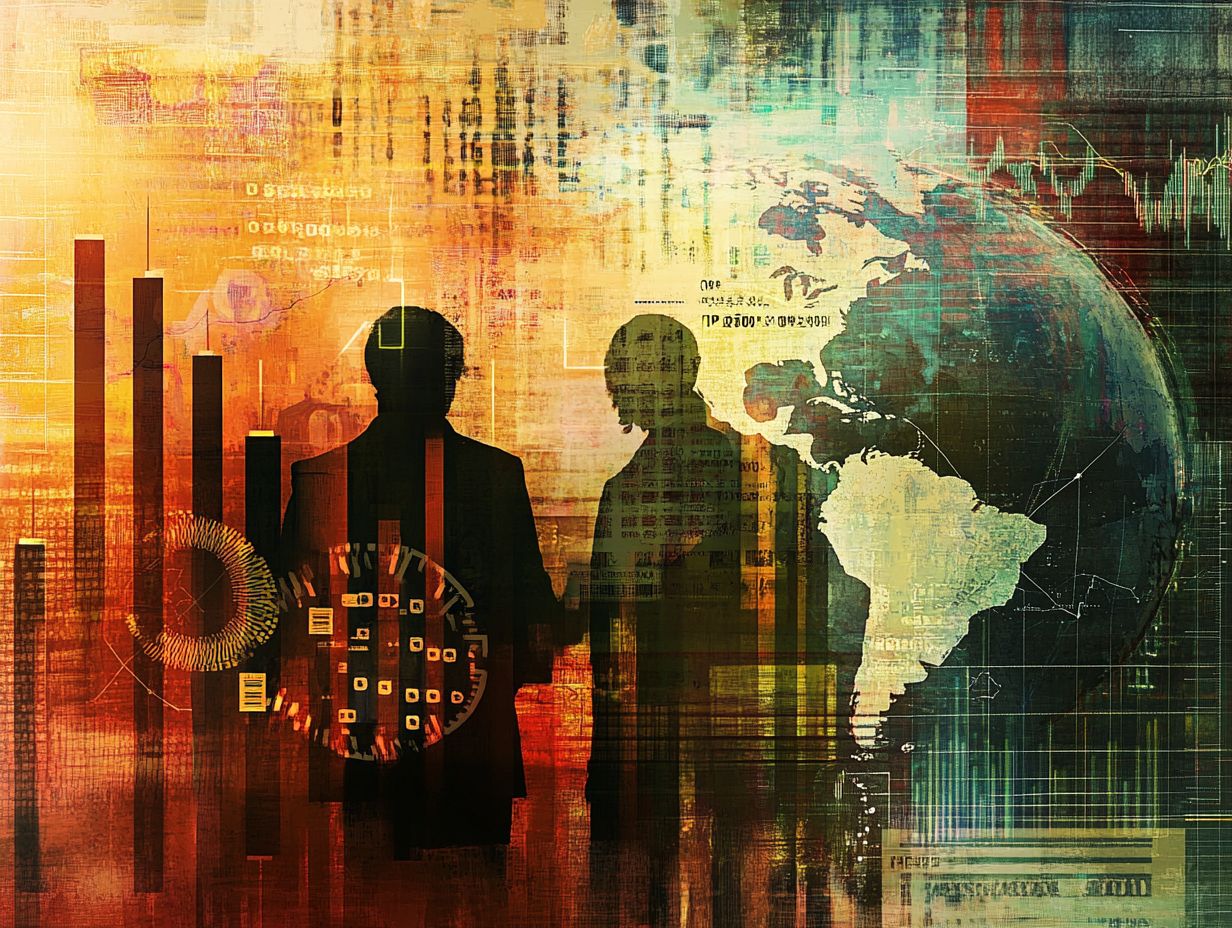
Some of the latest trends affecting global economic conditions include changing consumer behavior, technological advancements, climate change, and geopolitical shifts.
How are changing consumer behavior and trends impacting the global economy?
Changing consumer behavior, such as the shift towards e-commerce and increasing demand for sustainable products, impacts global economic conditions by altering traditional business models and supply chains.
What role do technological advancements play in shaping the global economy?
Technological advancements, such as automation and artificial intelligence, revolutionize industries and change how businesses operate, ultimately impacting global economic conditions.
How is climate change affecting the global economy?
Climate change impacts the global economy in various ways, including increasing natural disasters, rising sea levels, and changing weather patterns. These factors can disrupt supply chains, decrease productivity, and lead to economic losses.
What geopolitical shifts are currently influencing global economic conditions?
Geopolitical shifts, such as trade wars and political instability, significantly impact global economic conditions by creating trade barriers, decreasing consumer confidence, and affecting currency values.
What are some potential consequences of the latest trends on the global economy?
Some potential consequences of the latest trends affecting global economic conditions include increased competition, changing market dynamics, and potential economic downturns or recessions.
Stay informed and adapt to these trends to thrive in the evolving economy!

